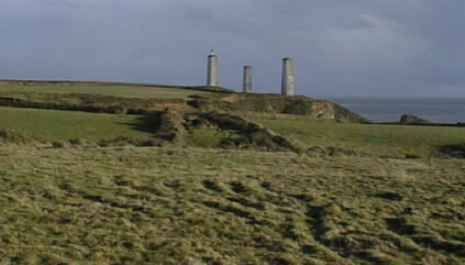

To find Ireland's second Metal Man take the road from Waterford, drive through the picturesque seaside resort of Tramore and head up Westown Hill to Rocketts Pub. John O' Brien and his son Andre now run this famous Irish drinking house which overlooks Tramore's Metal Man. You can see him, out of the bar window, looking sad on his pillar up on the cliff top at Newtown Head.
I have John to thank for introducing me to Andy Taylor's classic book Tramore of Long Ago, which he insisted on telephoning his wife Anne to bring up from the house as we sat drinking pints on an icy cold Saturday evening in January 1999.
Read this, he said tantalizingly, and then I'll show you the third Metal Man.
Hailstones battered the windows and the gale howled outside as I opened Andy's book,
took a deep swallow from the glass, and found myself back in my own village on the West
Coast of Ireland.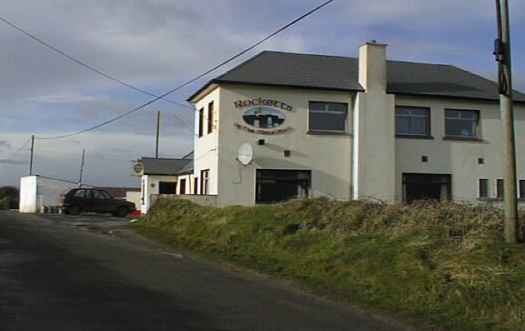
Andy wrote: Tramore's most famous personality has been standing on top of his 61-foot pillar since 1824, warning mariners of the dangerous Tramore Bay. The origin of this impressive figure dates from the early years of the 19th century when a sailing vessel passed on the wrong side of a reef of rocks off Rosses Point and foundered with the loss of all hands. The wife of the Captain of the ill-fated vessel was so appalled by the tragedy that she petitioned the Authorities to place some sort of warning signal on the dangerous rocks, and as the authorities seemed to address the matter with a lot more wages than actions, the good lady decided to do something about it herself. Being a woman of some means she commissioned the sculptor, Thomas Kirk, to design some form of warning signal, and so was created the small model of a Metal Man which Kirk exhibited at an exhibition in London in 1817. That catalogue described it as the figure of a British Tar, a sketch designed for a colossal statue to stand on a dangerous rock in the sea near the harbour of Sligo as a beacon. Two years later the Ballast Board commissioned John Clarke to cast a metal figure from Kirk's model at a cost of 80 pounds. It was one of four gigantic figures cast at that time, our man being one of them. The whereabouts of the other two remain a mystery. Many suggestions have been bandied around - Sydney Harbour, Montevideo, Norway and even Boston in the USA. However, Tony Caulfield, an avid Marine enthusiast, wrote to the Library in Sydney, Australia, and they assured him that there was never any such statue in Sydney. Personally, I would image that they were probably lost in transit to some foreign destinations and are now lying at the bottom of Davy Jones' Locker. Thankfully Tramore and Sligo have that old man of the sea still in their midst.
Andy Taylor's story answered some questions in our search for the history of the Metal Man, but opened others. In the Rosses Point version of the story it was the Shipping Company which commissioned Thomas Kirk to design the statue. In Tramore it was the Captain's wife. And who was Thomas Kirk?
He built Nelson's Pillar and we blew it up, said an old man in another bar in Tramore as he downed a half one and shuffled away.
Nelson's Pillar dominated O'Connell Street in Dublin until the IRA blasted him into orbit in 1966. The head of Ireland's first man in space came back to earth and was exhibited at a concert by the Dubliners in the capital soon afterwards.
The children of Edmund Rice Primary School in Tramore have taken the Metal Man to their heart and they told me about a hidden world, which exists beneath his feet.
Under his headland there are two caves, the Cathoir or the Metal Man's Chair is one and the other is the Cave of the Birds.
 There is a
saying that if a woman hops barefooted all around the centre pillar three times she will
be married within the year.
There is a
saying that if a woman hops barefooted all around the centre pillar three times she will
be married within the year.
Let's return now to Andy Taylor's account of the events of 1821.
The pillars, three on Newtown Head and two on Brownstone Head were erected in June. During the work on the building of the pillars on Newtown Head. Two masons were in the act of ascending to the top of one of the pillars by means of an apparatus used for hoisting up stones, etc., when the rope by which they were suspended gave way at the spliced part, and they were hurled to the ground from a height of 37 feet. One of them, John Burke, was so badly injured that he was removed to the Leper Hospital in Waterford Infirmary. He had suffered a fractured spine besides numerous other fractures and contusions. The other mason, named Flaherty, was a native of Tramore, was also in a pitiable state. John Burke died in October and left a young family. Flaherty, the survivor of the accident also had a young family to support. John Cooke, the Protestant Rector, made application to the Board of Works and Chamber of Commerce for some financial help for the families, but it was refused as those two bodies replied that their funds could not be appropriated to such relief. Consequently, the plight of the two families, especially the widow and her three hapless children, was placed before the public - all donations, however small, were to be sent to Rev Cooke, Doctor Burnitt, Doctor Mackessy, or any of the Waterford Newspaper offices. In 1894 there was another tragedy when a Westown Man named Michael Kirwan fell from the Metal Man while painting the figure. He was also married and had a family to support.
On Saturday, September 27th, 1823, the Waterford Mirror under the heading Ship News had the following news item:
A large iron cast model of a man has been landed here from Dublin, and has been sent to be placed upon the middle tower of the three towers lately built at Newtown Head, the Western Point of Tramore Bay in this county, with the left hand a akimbo, and the right hand extended out as a warning to vessels to keep off from that dangerous shore. And so in early 1823 he was positioned on the pillar with right hand pointed seawards, and is supposed to call aloud to mariners:
Keep off, good ship; keep off from me,
For I'm the rock of misery.
This rhyme recalls the number of vessels, in the days of the wooden sailing ships, that
were ground to powder on the rocks which bound the precipitous coast of the bay. His
Metallic Highness quickly became a favourite with tourists who never failed to make the
trek either on foot or by pony and trap to his royal domain at Westown. For some people it
was an annual pilgrimage just to feast their eyes on his sea-beaten countenance. For
others there was a much deeper motive - a fanciful legend legend declared that to hop
around the rock-strewn base of the pillar was a prelude to marriage before the year was
over - to those of course, not bound already in the golden fetters. It certainly was then
a Mecca for the tourists, but sad to say, today's tourists are denied access to see this
giant of a man who has faithfully stood on his perch there for more than 170 years.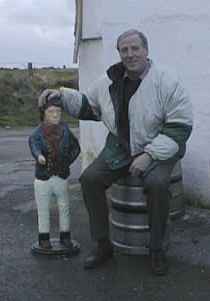
John O'Brien turned the key in the lock, opened the door of his beer shed, pulled back barrels of Guinness and Smithwicks and struggled into the winter sunlight clutching the third Metal Man.
He came from a big house in Waterford, he said, and the man who bought him sold him to me for a hundred pounds. I put him on the roof of the pub where he could see his older brother across on the cliff.
But one local youth in Tramore had better plans for the Little Metal Man. He scaled the walls of the Rocket and pushed him over the eves. The Metal Man tumbled down to the lane below and broke into pieces. John told me how he turned to Chris Shaw, a Dublin sculptor for help, and the Little Metal Man was dispatched to the capital for surgery.
Chris discovered that the statue was constructed in the same way as the Metal Man here in Tramore, said John. Inside the casting he found traces of red sandstone clay used to make the original mould.
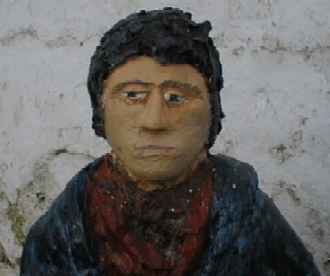 Now,
fully restored the Little Metal Man is ready to return to the roof of Rocket's Pub.
Now,
fully restored the Little Metal Man is ready to return to the roof of Rocket's Pub.
But is he the original model lovingly crafted by Thomas Kirk and shown at the exhibition in London in 1817?
Michael Moore, who lectures at the National College of Art and Design, told me that
most of Waterford and Tramore stands on red sandstone clay which suggests that the model
was moulded locally. But then you have to look at the way he was built, he said, who
else would go to the expense of following the original plans, unless he was the man who
drew up the plans. I think you are looking at the Little Metal Man cast by Thomas Kirk.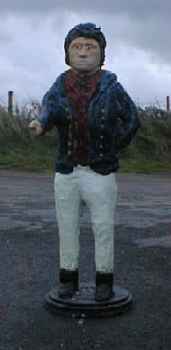
The Tramore Metal Man leads a lonely life on his pillar on the cliff; the Irish Lights no longer paint his royal blue coat, his white trousers are stained with rust and young girls are unable to dance one footed around his towering pedestal.
The cave below is empty; boats no longer come.
But the Little Metal Man is about to be hoisted onto his pedestal outside Rocket's Pub, and thanks to John O'Brien, the town's most famous person may yet enjoy a new renaissance.